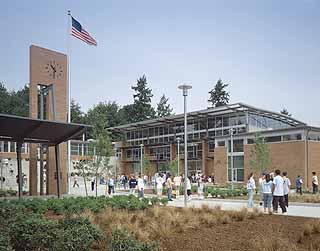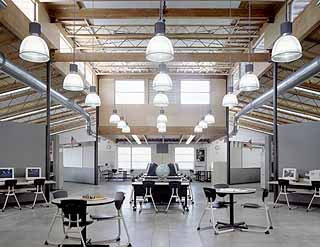|
Subscribe / Renew |
|
|
Contact Us |
|
| ► Subscribe to our Free Weekly Newsletter | |
| home | Welcome, sign in or click here to subscribe. | login |
Construction
| |
 |
August 12, 2004
Achieve good design within budget
Mahlum Architects

Reifert
|
Ideally, planning starts with a district-wide evaluation of existing structures, a community "visioning" process that helps to identify what constituents want from their education dollars, and site visits to other schools.
As district representatives visit other schools we ask them to consider a series of questions, all of which may affect the final budget. Some of the questions:
How does the architecture allow for personalization? How does the space promote strong relationships between students and teachers?

Photos courtesy of Mahlum Architects
Northshore Junior High in Bothell has a courtyard and series of monumental steps designed to encourage students to gather and socialize.
|
The newly rehabilitated Northshore Junior High School in Bothell, for example, has a courtyard and series of monumental steps that encourage students to gather and socialize.
The courtyard reinforces the school identity, welcomes visitors and provides an outdoor home to student art and class discussion in a seamless extension of interior learning environments.
Inside, clustered classrooms, open team areas and other settings provide a range of opportunities for learning: small group work, independent work, projects, experiments, research, interaction with adults, construction of projects and exploration of the arts.
How is student work exhibited, performed and displayed?
In my experience, the most engaging schools are plastered with artwork and examples of student work. To accommodate "performance-based assessments," districts need space where students can speak, make group presentations and listen to others.
Washington Middle School in Olympia found such a "performance space" as an extension to the library. Flexible and adaptable space saves dollars.
The most successful designs are drawn out of people in a free-flowing exercise that allows a group to set priorities, develop creative alternatives and build consensus.
The resulting plan reflects this consensus, outlines the most urgent needs and balances them against the available dollars. It is then up to architects who are sensitive to this balance to produce good designs that stay within budget.
Well-designed schools should:
They should be places where students want to learn and teachers want to teach. Something as simple as natural lighting, for example, boosts learning. Nationwide studies show that students are happier and healthier, and test scores improve with natural lighting. At Northshore, walls of glass and sun-filled corridors have replaced darkened hallways and small classroom windows.
Rather than a central hallway with classrooms on either side, many new schools today have small clusters of classrooms grouped around a common space where students can come together for more interaction.
Some districts have opted to create small schools within a large school environment. Cleveland High School in Seattle, with 1,000 students, has reorganized into four autonomous academies, and work is now under way on a design that will support that approach.

In Federal Way, Truman High School’s simple design comprises two rectangular-shaped buildings set side by side.
|
In addition to more natural light, schools are relying more on natural ventilation, recycling of rainwater and low volatile organic compounds in carpeting and paint to improve air quality.
Benjamin Franklin Elementary School in Kirkland will have natural ventilation in classrooms, windows oriented to maximize day light, and storm water collected on-site rather than piped away.
Districts can stay within budget if they abide by a few guidelines:
Truman High School in Federal Way comprises two simple rectangular-shaped buildings set side by side, but slightly offset from each other.
Tom McCall West Elementary School in Forest Grove, Ore., uses metal cladding and concrete masonry not typically associated with an elementary school.
Olympia's Washington Middle School was originally planned for 25,000 square feet of new building and 75,000 square feet of renovation. In our cost and structural evaluation, we looked at natural ventilation, wood frame construction and three identical classroom wings that could be inexpensively duplicated.
As a result the school will now comprise 75,000 square feet of new construction and 25,000 square feet of renovation -- for the same budget. And with this design, the district will have a modern school with appropriate day lighting, activity areas, 18 new classrooms, six new science rooms and an ecologically sound roof that harvests rainwater.
Gerald "Butch" Reifert is a principal at Mahlum Architects, which has offices in Seattle and Portland.
Other Stories:
- Fast-track school projects require careful planning
- A little cooperation goes a long way
- Misunderstood fungus exacts a costly toll
- Restoring order to the school-design process
- Stucco makes a comeback
- A second wind for historic schools
- New vocational center a model for innovation
- Architects are from Mars, educators are from Venus
- Alternative school-funding models pay off
- Research fuels UW space needs
- Schools to experiment with sustainability


